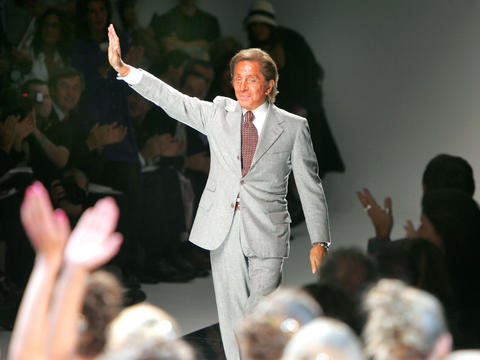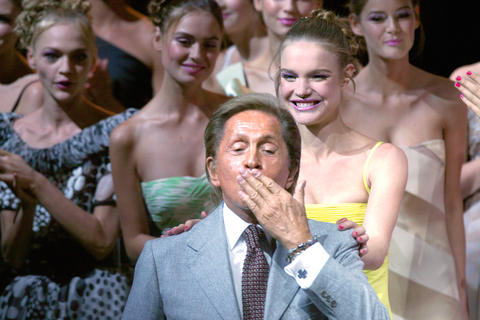Italian designer Valentino, who retired this week after 45 years business, has been called everything from the "Sheik of Chic" to "King of the Red Carpet." A perfectionist with an unparalleled sense of fit and fabric, he has dressed royalty, first ladies and movie stars in his signature scarlet dresses and tasteful couture. The designer unveiled his Swan Song collection in Paris yesterday.
Screen legend Sophia Loren summed up Valentino's appeal: "Femininity and glamour and beautiful things!" She has mixed feelings about his retirement.
"I think it's up to him to decide what he wants to do in his own life," she said. "What I feel about it? I'm a little bit sad, because he is one of the greatest." Born Valentino Garavani in 1932 in Voghera, Italy, he spent much of his teenage years in the local cinema admiring leading ladies like Rita Hayworth and Lana Turner.

PHOTO: AP
"I was crazy about film stars," Valentino said in an interview last year.
"All my life I was fascinated to see a beautiful woman coming down the staircase in a long gown. This was my dream since I was a child and it is for this reason that I am a designer," he said.
At 17, the designer convinced his parents to let him move to Paris, where he studied at the Fine Arts School and at the Chambre Syndicale de la Couture Parisienne, French fashion's governing body.

PHOTOS AFP
During apprenticeships at Jean Desses and Guy Laroche, Valentino demonstrated his skill for sketching and met influential style icons like the countess Jacqueline de Ribes.
By 1959, he was ready to set up shop on his own in Rome, opening a salon on the prestigious via Condotti with backing from his father.
The year after, he ran into Giancarlo Giammetti, the man who would help him build an empire. The two were a couple for 12 years and remain inseparable, in a relationship that is often compared to that of Yves Saint Laurent and Pierre Berge.
Valentino had his big breakthrough in Florence in 1962. His show was a hit and soon he was dressing clients like Elizabeth Taylor and Jackie Kennedy, who commissioned him to design a mourning wardrobe after the assassination of former US president John F. Kennedy in 1963.
Giammetti's business acumen has allowed Valentino to weather successive changes of ownership without ever losing creative control, while becoming wealthy enough to share the lifestyle of his jet-set patrons.
Last year, British-based private equity firm Permira bought the Valentino Fashion Group - which also includes the Hugo Boss and Marlboro Classics labels - for US$3.8 billion. It has appointed Alessandra Facchinetti, formerly of Gucci, to continue designing the women's line.
The 1970s seemed tailor-made for Valentino. Fashion was free and flirty, and life was fun as he partied at the legendary Studio 54 nightclub in New York and hung out with Andy Warhol.
Valentino was not fond of the 1980s, with its bouffant hairstyles and big shoulder pads, and even less of the grunge trend that followed. But throughout, he managed to win over new fans by staying true to his mantra: Keep a woman looking her best.
It helped that unlike Saint Laurent, Valentino was never tempted by substance abuse. A workaholic who often sketches late into the evening, he has always maintained an iron grip on his health and image.
Perma-tanned and impeccably coiffed, the designer owns lavish homes including a chateau near Paris, a 46m yacht and an art collection with works by Picasso, Miro and Basquiat.
After a cameo in the 2006 movie The Devil Wears Prada, Valentino is scheduled to hit the big screen again this year in Valentino: The Last Emperor, a documentary directed by Vanity Fair special correspondent Matt Tyrnauer.

The unexpected collapse of the recall campaigns is being viewed through many lenses, most of them skewed and self-absorbed. The international media unsurprisingly focuses on what they perceive as the message that Taiwanese voters were sending in the failure of the mass recall, especially to China, the US and to friendly Western nations. This made some sense prior to early last month. One of the main arguments used by recall campaigners for recalling Chinese Nationalist Party (KMT) lawmakers was that they were too pro-China, and by extension not to be trusted with defending the nation. Also by extension, that argument could be

Aug. 4 to Aug. 10 When Coca-Cola finally pushed its way into Taiwan’s market in 1968, it allegedly vowed to wipe out its major domestic rival Hey Song within five years. But Hey Song, which began as a manual operation in a family cow shed in 1925, had proven its resilience, surviving numerous setbacks — including the loss of autonomy and nearly all its assets due to the Japanese colonial government’s wartime economic policy. By the 1960s, Hey Song had risen to the top of Taiwan’s beverage industry. This success was driven not only by president Chang Wen-chi’s

Last week, on the heels of the recall election that turned out so badly for Taiwan, came the news that US President Donald Trump had blocked the transit of President William Lai (賴清德) through the US on his way to Latin America. A few days later the international media reported that in June a scheduled visit by Minister of National Defense Wellington Koo (顧立雄) for high level meetings was canceled by the US after China’s President Xi Jinping (習近平) asked Trump to curb US engagement with Taiwan during a June phone call. The cancellation of Lai’s transit was a gaudy

The centuries-old fiery Chinese spirit baijiu (白酒), long associated with business dinners, is being reshaped to appeal to younger generations as its makers adapt to changing times. Mostly distilled from sorghum, the clear but pungent liquor contains as much as 60 percent alcohol. It’s the usual choice for toasts of gan bei (乾杯), the Chinese expression for bottoms up, and raucous drinking games. “If you like to drink spirits and you’ve never had baijiu, it’s kind of like eating noodles but you’ve never had spaghetti,” said Jim Boyce, a Canadian writer and wine expert who founded World Baijiu Day a decade